|
Articles
Walter Tull
"FIRST
BLACK ARMY OFFICER, FOOTBALLER, AND GREAT WAR HERO"
by Marilyn Stephenson-Knight
 Walter Daniel John Tull was the son of
Daniel Tull from Barbados. Descended from slaves, Walter became
the first black combat officer in the British army. As also the
first coloured outfield professional footballer he is claimed
with pride as one of Folkestone's famous sons. But was he? Or
was Walter Tull actually a Dovorian? Walter Daniel John Tull was the son of
Daniel Tull from Barbados. Descended from slaves, Walter became
the first black combat officer in the British army. As also the
first coloured outfield professional footballer he is claimed
with pride as one of Folkestone's famous sons. But was he? Or
was Walter Tull actually a Dovorian?
Walter became a 2nd Lieutenant
during the Great War. In March 1918, a month before his 30th
birthday, he was killed during an advance on Favreuil, France.
So well-liked was he in command that his men attempted under
heavy fire to recover his body for burial. But it was
impossible. Like 35,000 others who died in the region and have
no known grave, Walter is commemorated on the Arras Memorial.
He is named too on the war memorial at the
top of the Road of Remembrance in Folkestone, where so many
soldiers marched down the hill to embark for France. Walter's
name was placed there by his old school teacher. Mr Murray had
remembered his pupil for over twenty years, for by the time
Walter was nine both his parents were dead, and he and one of
his brothers, Edward, had been sent to an orphanage in London.
But Walter is remembered in Dover as well.
His name is on the Town War Memorial outside the Town Council
Offices at Maison Dieu House. Why? And why does he also appear
on the memorial at River?
Using many sources I gradually found an
answer. One of Walter's grandmothers was born in Folkestone. But
she spent most of her life in Hougham, Dover, with her farm
worker husband. He came from the village, and their daughter
Alice
 Palmer, Walter's mother, was born in March 1853 at Elms
Farm. It's at the extreme end of Elms Vale Road in Dover, and is
well known to us older residents as the "Conker Pond". We used
to ride our bikes along the lanes up there - and by a strange
twist of coincidence, it's the place where I spent many happy
childhood years learning to milk cows, bring in the harvest, and
collect eggs hidden in hay lofts. Palmer, Walter's mother, was born in March 1853 at Elms
Farm. It's at the extreme end of Elms Vale Road in Dover, and is
well known to us older residents as the "Conker Pond". We used
to ride our bikes along the lanes up there - and by a strange
twist of coincidence, it's the place where I spent many happy
childhood years learning to milk cows, bring in the harvest, and
collect eggs hidden in hay lofts.
Perhaps Alice did the same before she
joined her carpenter husband Daniel in Folkestone. But there she
settled to motherhood, with several children. The last child
born to the couple was Elsie. In 1895, when Elsie was three,
Alice died and the family was left motherless. Just over a year
later Daniel married again. His bride was Clara Palmer. Born at
Farthingloe in 1870 she was another Dover girl. She was also
Alice's niece.
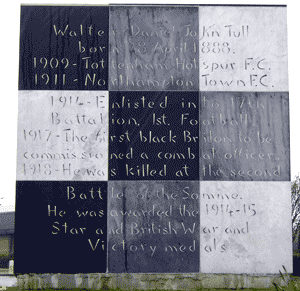 The marriage was short. In December 1897
Clara was widowed. Left with her aunt's children and her own
baby daughter Miriam* to care for, Clara was unable to manage.
The family was split up. But the two youngest children, Miriam
and Elsie, remained with her. When she married again in 1899,
they settled with Clara and her new husband William Beer just
outside Dover in Coldred. The marriage was short. In December 1897
Clara was widowed. Left with her aunt's children and her own
baby daughter Miriam* to care for, Clara was unable to manage.
The family was split up. But the two youngest children, Miriam
and Elsie, remained with her. When she married again in 1899,
they settled with Clara and her new husband William Beer just
outside Dover in Coldred.
By 1912 the family had moved closer to
Dover town, returning to William's birthplace. From their new
home near Whitfield Hill Elsie, in 1920, and Miriam, in 1924,
were married in the Parish Church in River. Walter was sent back
to England in 1916 to convalesce from war trauma. Disembarking
at Folkestone he probably visited the family in Kearsney before
returning fight on the Somme. He saw his sisters again in 1917,
just before gaining his ground-breaking commission.
This then is why Walter Tull, star for
Tottenham Hotspurs and Northampton, officer of the Middlesex
regiment, was commemorated in Dover. For despite his parents'
death and family separation, Walter's new family in Dover
remained in touch. Ever in their thoughts they ensured that in
1921 his name was inscribed on their Parish Memorial at River,
and in 1924 on the Dover Town Memorial.
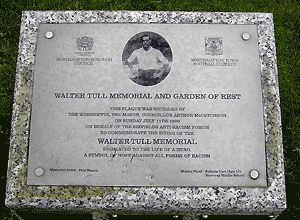 Walter Tull's careers in football and in
the army were illustrious. In recent years much has been made of
his overseas heritage, for he succeeded when prejudice was
strong. He overcame racism to become a great footballer, and he
overturned regulations forbidding non-whites from becoming
officers. But what seemed previously unknown is that Walter's
heritage was also from Dover. His mother was Dovorian and his
new family lived in Dover. The card on the wreath laid at the
unveiling of the River memorial read "From Mum and Dad, Elsie
and Miriam". Walter Tull is the embodiment of equality. His
roots lie in Barbados - and in Dover. Walter Tull's careers in football and in
the army were illustrious. In recent years much has been made of
his overseas heritage, for he succeeded when prejudice was
strong. He overcame racism to become a great footballer, and he
overturned regulations forbidding non-whites from becoming
officers. But what seemed previously unknown is that Walter's
heritage was also from Dover. His mother was Dovorian and his
new family lived in Dover. The card on the wreath laid at the
unveiling of the River memorial read "From Mum and Dad, Elsie
and Miriam". Walter Tull is the embodiment of equality. His
roots lie in Barbados - and in Dover.
When we watched the recent World Cup, we
saw many banners emblazoned "Football Against Racism". As a
pioneer Walter Tull is an icon. In 1999, at Northampton football
stadium, a memorial to him was unveiled. There's even a trophy
named after him.
Walter Tull broke the mould in the forces
too. Mentioned in dispatches for gallantry he disproved the
prejudice that coloured people were unfit for command. Popular
and brave, he was faithful to the end. Shoulder to shoulder with
his fellows he gave his life for his country.
Martin Luther King had a dream - but Walter
Daniel John Tull dreamt it first. Dover can be proud.
This article (without these pictures) first appeared in the Dover
Express, p10, 17th August 2006 * Miriam was
named after her aunt, Clara's sister, Miriam Ellen Elizabeth
Palmer, born 1880.
Pictures:
Walter Tull, from the Memorial Plaque at Northampton Football
Stadium
Road sign outside Northampton Football Stadium
The Memorial at Northampton Football Stadium
The Memorial Plaque at Northampton Football Stadium
| The Words on the Memorial
Read: |
The Words on the Plaque Read: |
|
Walter Daniel John Tull
born 28 April 1888
1909 - Tottenham Hotspur FC
1911 - Northampton Town FC
1914 - Enlisted into 17th Battalion, 1st Football
1917 - The first black Briton to be commissioned a
combat officer
1918 - He was killed at the second Battle of the
Somme
He was awarded the 1914-15 Star and British War and
Victory medals |
Walter Tull Memorial and Garden of Rest
This plaque was unveiled by
the Worshipful The Mayor, Councillor Arthur
McCutcheon
on Sunday July 11th 1999
on behalf of the Sixfields Anti-Racism Forum
to commemorate the siting of the
Walter Tull Memorial
dedicated to the life of a hero
a symbol of hope against all forms of racism
|
Some
Places Associated with Walter Tull
|
In 1911 Walter Tull (as "Walter Douglas Tull") is
recorded as being a visitor at the home of Theresa
Weston Cove, a widow. She and her family of sons
Gerald and David, and daughters Winifred, Grace, and
Dorothy, were living at 6 Kymberley Road, Harrow. |
|
 |
 |
|
26 Queen Street, Rushden |
33 Albany Road, Northampton
(address at enlistment) |
|
 |
|
North Board School, Folkestone (just around
the corner from 51 Walton, below, right) |
|
 |
 |
|
16 Allendale Street, Folkestone
(birth) (before at no 8) |
51 Walton Street, Folkestone
(where family lived) |
|
|
|
|

This is Cheriton Street. In 1861
Alice Palmer, future mother of Walter Tull, and her
brother Richard, were staying in this area with
their grandmother, Elizabeth.
Elizabeth was then aged 63, and
was the wife of Richard Smissen, a Farm Bailiff. |
|

The area is much changed since
that time; however there is a distinctive curve in
the road that Alice would recognise today, and just
possibly some of the houses might be familiar. |
Cheriton Cemetery, Folkestone

William
Tull
William Stephen Palmer Tull, Walter's older brother, also lies in a war grave.
He was a Sapper in the Royal Engineers, and died from
tuberculosis on 12th March
1920, aged 37. He had been gassed during the war.

He left a widow, Gertrude Mary Tull,
nee Boxer, from 59
Greenfield Road, Folkestone (right). He is buried at Cheriton,
Folkestone At the bottom of William's headstone are
the words: "Until the day breaks and the shadows flee away"
In the picture below can be seen the
distinctive CWGC stone on William's grave. In the foreground,
just a few graves away, is the grave of Frederick Charles Tull.,
whom we believe to be one of William's children.
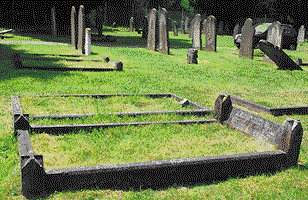 The
inscription on the headstone reads: The
inscription on the headstone reads: In Loving
Memory
of
Frederick Charles Tull
died 19 December 1916
aged 16 years We cannot, Lord, Thy purpose see
But all is well that's done by Thee

At the other end of the cemetery is the grave of Winifred Alice
Tull. She was William's youngest daughter, and died on 19 March
1914, aged 1 year and 11 months. Her grave is unmarked, but it
lies in the shadow of the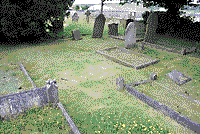 Commonwealth War Graves Cross of Sacrifice.
Commonwealth War Graves Cross of Sacrifice.
Also in an unmarked grave (left) is little
Bertha Susannah Tull. Born on 9 February 1881, she was just five weeks old when she died
in March. She was the firstborn child of Daniel and Alice Tull; the minister who conducted the funeral service was the one
who had married them just the year before. .
Daniel and Alice Tull
Not
far from William's grave is that of his parents, Daniel and
Alice Tull.
Their headstone reads:

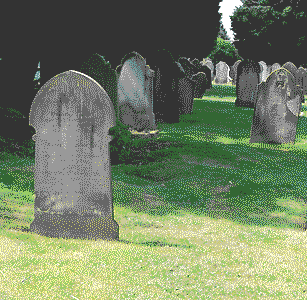 Loving memory Loving memory
of Daniel
Tull
who died Dec 11 1897
aged 41 years
His end was peace
also Alice Elizabeth
his wife
who died April 14 1895
aged 42
years also of their son
2nd Lt Walter Daniel Tull
23rd Middlesex Regt
who fell in action March 25 1918
aged 29
years
all pictures Simon John Chambers
|